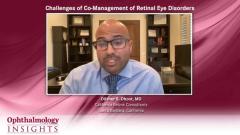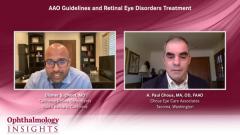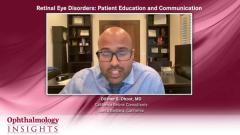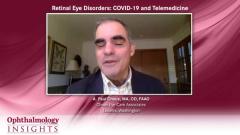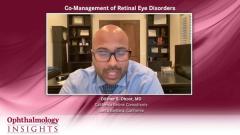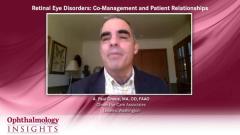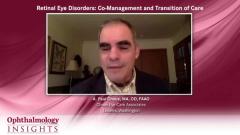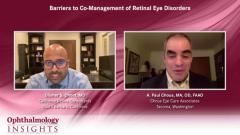
Clinical Overview of Retinal Disorders
Dilsher S. Dhoot, MD, and A. Paul Chous, MA, OD, FAAO, discuss the co-management of retinal eye disorders and provide a clinical overview of the disease.
Episodes in this series

Dilsher S. Dhoot, MD: Welcome, everybody. It’s a pleasure to be here with you on behalf of Ophthalmology Times® and Optometry Times®, discussing collaborative care of patients with retinal eye disorders. My name is Dilsher Dhoot. I’m with California Retinal Consultants and the Retina Consultants of America, Santa Barbara, California. I’m delighted to be here with my cofaculty Paul Chous, who I will introduce now, Paul.
A. Paul Chous, MA, OD, FAAO: Hi, thanks so much, Dilsher. I’m Paul Chous. I’m an optometrist in Tacoma, Washington. I have a practice that emphasizes diabetes eye care and education. I’m a diabetes educator. I’m across the street from a big endocrine practice, and I’m also an adjunct professor of optometry at the Western University of Health Sciences in Pomona, California. It’s a real honor to be here talking with you tonight, Dr Dhoot.
Dilsher S. Dhoot, MD: Fantastic. We’ve got some great topics to discuss. Paul and I are going to have a conversation regarding some of these retinal disorders and management and how optometrists and retina specialists can collaborate to provide the best care for our patients. We’re going to go through these questions, and I’ll be asking questions of Paul, and he’ll be kicking back some questions to me. We’re going to get started.
A. Paul Chous, MA, OD, FAAO: I’ll start then. Dilsher, what are some of the more common retinal disorders that you’re getting referred to you, not only from optometrists but from general ophthalmologists, as well? And what are some of the challenges in making the correct diagnosis from your referring partners in eye care?
Dilsher S. Dhoot, MD: Sure. We get a potpourri of referrals, but most common, of course, are the ones you might think: diabetes, diabetic retinopathy, and diabetic macular edema are very common, especially in my Central Valley practice. I practice in Bakersfield, California. We have a fair number of diabetics. We see macular degeneration, both dry and wet. Both those diagnoses, macular degeneration and diabetes, are probably No. 1 and 2. Following that, we have a lot of patients with retinal vein occlusion, branch retinal vein occlusion or central retinal vein occlusion. Then we get into more surgical type cases, such as retinal detachment. I’d say those are the most common things. We do see vitreoretinal interface disorders, such as epiretinal membrane, vitreomacular traction, and then other things like macular hole. Then we get into some of the weeds and the zebras.
A. Paul Chous, MA, OD, FAAO: Right, the rarer disorders. Can you comment on the relationship between endocrine and even cardiovascular diseases and retinal disorders? Do you have any thoughts about those particular entities and retinal disease?
Dilsher S. Dhoot, MD: It’s definitely cliche, but we often hear that the eye is the window into systemic disease. We certainly see manifestations of systemic diseases, both endocrine and cardiovascular, in the eye. Most commonly we think of diabetes, and we see manifestations of diabetes, and we can get a good gauge of how patients are doing with managing their diabetes. Also cardiovascular disorders, in particular hypertensive type disorders, retinal vein occlusion, and artery occlusions, these are all things that are commonly seen, and sometimes we’re even diagnosing these patients with systemic conditions for the first time.
I’m sure in your practice too, you may have these patients present and they’re unaware that they even have the diagnosis of diabetes or hypertension. We’re the first line, checking their blood pressure, we see that they’re elevated. In fact, you guys are really the first line, but a lot of times we’ll get patients sent to us too, where we’re the first ones to consider diagnosing them. Is that the case for you, too, there in Tacoma?
A. Paul Chous, MA, OD, FAAO: Oh, totally. The surprising thing is a lot of my patients at the first encounter with me, they’re here because they’ve got presbyopia and their arms aren’t long enough anymore, and they’ve never had their eyes even looked at before. It’s not uncommon that I’ll find patients with untreated hypertension and undiagnosed diabetes with retinal manifestations. I think in optometry in a lot of ways we’re on the front lines, we see a fair number of patients who don’t see or even have a primary care provider, and then we rely on you in ophthalmology, retina particularly, to evaluate and treat patients who have vision threatening complications like venous occlusions and sometimes more advanced retinopathy.
Dilsher S. Dhoot, MD: Yes, it’s remarkable. It’s been a good thing that payers have mandated eye exams for patients with endocrine disorders in particular, like diabetes. I think that it’s helped us catch patients earlier in the scheme of things and try to deliver interventions sooner so that patients can have better vision for the majority of their lives. That’s been a great thing. You’re exactly right. I think optometrists serve a frontline role, and then secondarily, we see some telemedicine, and we may get into that in a bit too.
TRANSCRIPT EDITED FOR CLARITY
Newsletter
Don’t miss out—get Ophthalmology Times updates on the latest clinical advancements and expert interviews, straight to your inbox.


